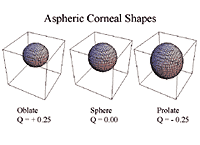Method of estimating corneal thickness after LASIK should improve safety
HOUSTON — Predicting the true ablation depth produced with current excimer laser ablation patterns can be challenging for refractive surgeons. A new method for estimating thickness of the unmodified cornea following laser in situ keratomileusis (LASIK) should help improve the safety of photorefractive procedures.
“On first consideration, the results of the calculations may seem somewhat surprising,” said John R. Moran, MD, PhD, in private group practice here. “However, it can be shown that, independent of the laser or treatment strategy used for a given ablation, inducing one central radius of curvature, at one treatment zone size, with one aspheric shape, can result in only one depth.” In other words, “the theoretical minimum depth of a particular ablation profile is a discrete function with a unique solution. Various strategies, such as dividing the treatment into a cross cylinder, using cylinder transposition or multiple zones, yield different depths for the same central curvature, but also give differently shaped postoperative corneas.”
Dr. Moran, whose doctorate is in chemistry, began his work in corneal modeling and ablation kinetics while an ophthalmology resident at the Storm Eye Institute in Charleston, S.C. “Many of the mathematical techniques and concepts used in chemical research are applicable to studying the cornea and the ablation process,” Dr. Moran said. He continued the work as a cornea fellow and collaborated with Jack Holladay, MD, in creating the new method for estimating ablation depth and effective optical zone size. “The commonly used approximations of Munnerlyn’s formula were found to underestimate the central ablation depth by 15% to 30%, whereas this new approximation reduces error to only ±5%,” Dr. Moran said.
Zone sizes confusing
 ---According to Dr.
Moran, inducing one central radius of curvature, at one treatment zone
size, with one aspheric shape, can result in only one depth.
---According to Dr.
Moran, inducing one central radius of curvature, at one treatment zone
size, with one aspheric shape, can result in only one depth.
Radius of curvature, expressed either in units of millimeters or
diopters, “is a familiar concept to the refractive surgeon,” said Dr.
Moran at the American Society of Cataract and Refractive Surgery annual
meeting. On the other hand, “treatment and effective optical zone sizes
are confusing, simply because of the nomenclature that is currently used.”
The shape factor or asphericity of an ablation profile or cornea is
“slightly less familiar to most people. However, it is absolutely critical
to include asphericity in any analysis of spherical aberrations or plan for
custom ablations.” Again, “calculated depth is an exact function of
three variables: radius, zone size and shape.”
When evaluating different excimer lasers and treatment strategies, Dr. Moran said that surgeons need to be able to distinguish between the treatment zone, the refractive zone and the optical zone. “The treatment zone is that area of the cornea modified by the laser, whereas the refractive zone is the area where the laser is attempting to induce the desired refractive change,” Dr. Moran said.
The true optical zone (the most important determinant of visual function) is dependent on “how you define optical zone and the amount of treatment,” Dr. Moran said. For example, “if we define the optical zone as those points on the cornea that are within ±15 D of the desired refractive power, then the whole cornea is the optical zone. But a more realistic value is to choose ±0.5 D. If you do this, you find that the optical zone can be significantly smaller than the treatment zone, even in moderate corrections.” In extreme corrections, such as –11 D, the effective optical zone size can be less than 2 mm in diameter.
Corneal shapes
Dr. Moran predicted that, in coming years, practitioners would hear much more about additional descriptors of corneal shape. “Characterizations such as ‘asphericity’ provide a more realistic description of the subtle and complex shape of the cornea,” he said. For example, consider three limiting cases of asphericity: the prolate, spherical and oblate ellipsoids. “As shown in the figure, three corneas with identical central radii of curvature are looking straight up at the ceiling,” Dr. Moran said. “The prolate cornea is less steep in the periphery than is the spherical or oblate cornea. This causes the prolate shape to minimize spherical aberrations.”
Measuring three 44 D corneas of different asphericities using a keratometer “would not allow you to tell them apart,” Dr. Moran said. “This is because keratometers measure only radius, not asphericity. But the magnitude of spherical aberrations depends directly on the degree of asphericity. That’s why we use aspheric 20-D lenses to look at the retina. A spherical or oblate 20-D lens would be virtually useless because of severe distortions.” Similarly, “a prolate cornea tends to minimize spherical aberration, while the oblate cornea maximizes spherical aberration.”
Future ablation software
The postoperative corneas produced by all excimer laser treatments that are currently approved by the Food and Drug Administration are more oblate than the corresponding preoperative cornea, Dr. Moran said. “That is one reason why patients can have 20/20 vision and perfect keratometry, yet still feel miserable after LASIK. The next generation of excimer laser ablation software will be able to correct many of these problems,” he said.
In conclusion, “one radius, one size, one shape, equals one depth,” Dr. Moran said. However, “nothing is free. You’re trading something — usually optical zone size — if you’re saving depth. Almost every laser today creates an oblate cornea. This results in shallower treatments, but also smaller effective optical zone sizes.”
For Your Information:
- John R. Moran, MD, PhD, is the founder of Moran Research and Consulting Inc., a software and diagnostic instrument development group specializing in custom ablation and topographic software. He can be reached at 3000 Bissonnet St., Houston, TX 77005; voice/fax: (713) 838-1976; e-mail: moranresearch@aol.com.
